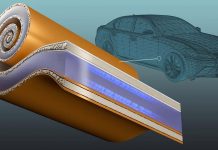
Researchers at the Fraunhofer Institute for Applied Optics and Precision Engineering IOF have developed a cutting-edge turn signal technology that aims to significantly improve road safety.
This new dynamic turn signal is designed to be highly visible even during daylight, using advanced micro-optical projectors.
The innovative technology will be showcased for the first time at the OPTATEC 2024 event in Frankfurt from May 14 to 16.
Traditional turn signals can sometimes be difficult to see due to small sizes, blind spots, or poor visibility conditions.
This can lead to dangerous situations on the road, especially if a driver’s intent to turn or change lanes is missed by other road users like cyclists or pedestrians.
The dynamic turn signal created by Fraunhofer IOF addresses these issues head-on. Despite its compact size of just 35 x 35 x 55 millimeters, the new device achieves an illuminance of over 7,000 lux, making it incredibly bright.
It features a unique chase-light effect with chevron patterns that are distinctly visible even under strong sunlight.
One of the key innovations in this technology is the elimination of traditional absorptive mask layers found in conventional projection systems, which can cause light loss and reduce the lifespan of projectors.
Instead, the team at Fraunhofer IOF has developed a method that uses microlens arrays (MLA) for pattern generation and beam shaping.
These MLAs are arranged in two layers: the first consists of chevron-shaped microlenses that catch incoming light, and the second has smaller square lenses that direct the light outwards.
By adjusting the angles at which light hits these lenses, the system can project dynamic sequences of chevrons directly onto the road. This not only enhances visibility but also allows for the projection of multiple signals from a single unit, simplifying installation and reducing costs and space requirements.
The microlens arrays are crafted using grayscale lithography, a precision technique that creates detailed patterns on a master mold. These are then replicated onto tandem arrays combining polymer and glass.
This material pairing is chosen for its ability to finely tune optical properties—the polymer can be precisely molded onto the glass, ensuring optimal light control and durability.
Furthermore, these components can be produced cost-effectively through processes like injection molding or hot embossing. These methods allow for the production of high-quality optical parts on larger or even curved surfaces without sacrificing performance.
The application of this technology extends beyond just making turn signals clearer. It plays a crucial role in Car2X communication—where cars communicate with other vehicles and road users, enhancing the overall safety and efficiency of road traffic.
As we move towards more intelligent transportation systems and autonomous driving, technologies like this projected turn signal are pivotal in ensuring safe and effective communication on the roads.



